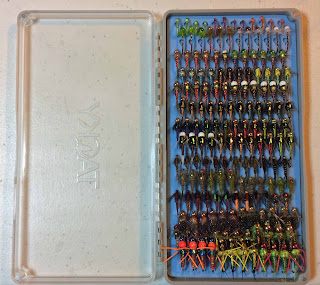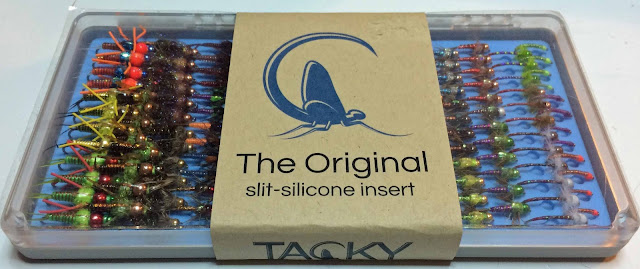~By: Lance Dean | April 7, 2015
My initial thought after seeing the Tacky Fly Box on the web was “It is just another fly box”, and I didn’t give it another thought. Then I read a couple reviews that peaked my interest, not enough to go buy one but enough to do more research. I went to the Tacky website and read the specs for the Tacky Fly box (found here) and their sales pitches for the box. When I was done researching these reviews and the Tacky website, I decided that I needed to see one of the fly boxes for myself. I wanted to know what this “Patent Pending Slit Silicone storage system [that] anchors the flies unlike anything else” was and what it meant. (“Tacky Fly Box”) I like silicon, I like the feel, the durability and the look of silicon, but how would it fit as part of a fly box. My first fly box was a cheap foam box that you punctured to hold flies. I used these cheap fly boxes for a few years. They were lite-weight, floated and held flies just fine. When they no longer held hooks very well, ripped or just plain wore out I just replaced them with similar fly boxes. I thought I was in heaven when I received my first C&F Design fly box by Scientific Anglers. It was a lite-weight fly box with slitted foam and although it didn’t float it had a cool fly-threader to help thread tippet into the eye of a fly. I still use this box for trout flies, and although this box is old and beginning to lose its hook holding ability I am still content using it. So when Tacky announced that they were going to be coming out with this new box that not only held flies like glue and had the durability of Rocky Balboa, I was a bit skeptical.
The first Tacky Fly Box that I had the opportunity to be personal with was at the Scheels in Sandy, Utah. When I picked it up and felt the strength of the polycarbonate box (I didn’t actually feel the polycarbonate because Tacky put a plastic film over it, too I assume, protect the case from scratches) and seen the light blue silicon sheet lying in the bottom of it, I decided that it seemed like a nice box, but I still didn’t see what all the fuss was about. It wasn’t until I opened it and felt the silicon in the bottom of the Tacky Fly Box that I fell I love with it. The silicon sheet had a rubber feel to it that when pressed would reshape itself almost immediately after I stopped applying pressure. This intrigued me, Did Tacky solve a fly fishing problem that I didn’t realize I had? The answer to that has to be a big, “YES!!!” I never really considered that I could have a box that would never wear out or one where after falling out of my vest and onto the ground, all the flies would stay where I put them rather than fall out of their slots. I guess I just got used to placing flies back in their slots and buying a new box here and there to replace worn out boxes.
So if you can’t already tell, I bought that Tacky Fly Box. I figured that at roughly twenty-five dollars which is about five to ten more dollars than I typically pay for a cheap box and if this fly box lasts as long as I think it will than I am actually saving money buying one. When I got home I put a few flies into it and dropped in a few times to see if the flies would come out. They did not. Now that it has been three months that I have had flies in this box, I decided to test it again, so I dropped the Tacky Fly Box from about 4 feet in the air on my living room floor 5 times is a row and the flies stayed in there slots. Granted the floor was carpet, but when are you ever going to drop a fly box five time right in a row. And no, I am not going to purposely drop it on the ground outside to test it that way because I don’t want to risk scratching the case.
Weighing in at roughly 5.2 ounces (I weighed mine), the Tacky Fly Box is lighter than any other hard fly box that I own of roughly the same dimensions. The other ones weigh approximately 6.5 ounces granted they are deeper than the Tacky boxes, so they would probably weigh about the same if the Tacky boxes were just as deep as these other fly boxes. The Tacky fly box holds 168 flies and the box that I was using before I got the tacky holds 125 flies without the swing leaf insert which I do not use. So in the long run the Tacky fly box can hold more flies at a lighter weight then my other box of the same width and length.
I have found a couple drawbacks to the Tacky Fly Box, like if you use it for dry flies the flies need to sit in the box at an angle so the hackle won’t be crushed and don’t even think about putting any flies with any size into this box, meaty streamers are just to big to put into the Original Tacky Fly Box.
One thing I have noticed about Tacky is that
they are working on new things to make the storing of flies more efficient. Just recently they released a new Tacky Fly Box that they call the Day Packer, the box is not as long or as wide the Original Tacky fly box, but is the same depth. Despite the Day Packer being a smaller box it holds 180 flies. That’s slightly more nymphs than the Original Tacky box packed into a smaller frame. This just goes to show you that Tacky does bring out new things so hopefully we will see some sort of fly box that hold streamers and dry flies more efficiently than the Original and the Day Packer fly boxes.
The point is that the Tacky Fly Box has grown on me it has become my favorite nymph fly box that is an extremely durable fly box that is fairly light-weight and securely holds a ton of hooks very securely even after taking flies out of one slot and putting another fly in its place over and over again.
Thank you, Tacky for making such an efficient and durable fly box. Please create a streamer and dry fly box soon.
Please Note: I think its only right for me to state that I was not asked by Tacky Fly Fishing to do this review and that the Original Tacky Fly Boxes used for this review I bought.
 |
| Logo on cardboard sleeve of the Tacky Fly Box. |
 |
| Original Tacky Fly Box - Filled |
 |
| Three of my fly boxes. |
 |
| Depth difference. |
I have found a couple drawbacks to the Tacky Fly Box, like if you use it for dry flies the flies need to sit in the box at an angle so the hackle won’t be crushed and don’t even think about putting any flies with any size into this box, meaty streamers are just to big to put into the Original Tacky Fly Box.
One thing I have noticed about Tacky is that
 |
The point is that the Tacky Fly Box has grown on me it has become my favorite nymph fly box that is an extremely durable fly box that is fairly light-weight and securely holds a ton of hooks very securely even after taking flies out of one slot and putting another fly in its place over and over again.
Thank you, Tacky for making such an efficient and durable fly box. Please create a streamer and dry fly box soon.
Please Note: I think its only right for me to state that I was not asked by Tacky Fly Fishing to do this review and that the Original Tacky Fly Boxes used for this review I bought.
- Tacky Fly Box. Advertisement. 1 April. 2015 < http://tackyflyfishing.com/the-original-tacky-fly-box/>
Tags:
Reviews

